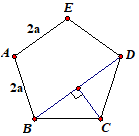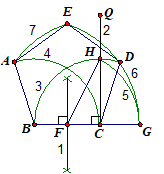|
We find the length of the diagonal first. ÐBCD = 108° BD = 2´2a sin 54° = 4a cos 36° Let q = 36°; 5q = 180; 3q = 180° – 2q cos 3q = cos(180° – 2q) 4 cos3 q – 3 cos q = – cos 2q = 1 – 2 cos2 q 4 cos3 q + 2 cos2 q – 3 cos q – 1 = 0 (cos q + 1)(4 cos2 q – 2cos q – 1) = 0
Steps: 1. Locate the mid-point F of BC. 2. Through C, draw a line CH perpendicular to BC. 3. Use C as centre, BC as radius to draw an arc BHD, cutting the line CH at H. Join FH.
By
Pythagoras' theorem on ΔCFH, FH =
4. Use B as centre, BC as radius to draw an arc AC. 5. Use F as centre, FH as radius to draw an arc GH, cutting BC produced at G.
6. Use B as centre, BG as radius to draw an arc EDG, cutting the arc BHD at D. BG is the length of diagonal of the pentagon. 7. Use C as centre, BG as radius to draw an arc AE, cutting the arc in step 4 at A, and also cutting the arc in step 6 at E. Join ABCDE. This is the required regular pentagon. |
|
|
|

